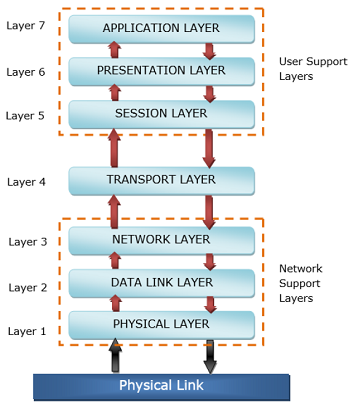
 Data Structure
Data Structure Networking
Networking RDBMS
RDBMS Operating System
Operating System Java
Java MS Excel
MS Excel iOS
iOS HTML
HTML CSS
CSS Android
Android Python
Python C Programming
C Programming C++
C++ C#
C# MongoDB
MongoDB MySQL
MySQL Javascript
Javascript PHP
PHP
- Selected Reading
- UPSC IAS Exams Notes
- Developer's Best Practices
- Questions and Answers
- Effective Resume Writing
- HR Interview Questions
- Computer Glossary
- Who is Who
The OSI Reference Model
OSI or Open System Interconnection model was developed by International Standards Organization (ISO). It gives a layered networking framework that conceptualizes how communications should be done between heterogeneous systems. It has seven interconnected layers. The seven layers of the OSI Model are a physical layer, data link layer, network layer, transport layer, session layer, presentation layer, and application layer, as shown in the following diagram ?

The physical layer, data link layer and the network layer are the network support layers. The layers manage a physical transfer of data from one device to another. Session layer, presentation layer, and application layer are the user support layers. These layers allow communication among unrelated software in dissimilar environments. Transport layer links the two groups.
The main functions of each of the layers are as follows ?
- Physical Layer ? Its function is to transmit individual bits from one node to another over a physical medium.
- Data Link Layer ? It is responsible for the reliable transfer of data frames from one node to another connected by the physical layer.
- Network Layer ? It manages the delivery of individual data packets from source to destination through appropriate addressing and routing.
- Transport Layer ?It is responsible for delivery of the entire message from the source host to destination host.
- Session Layer ? It establishes sessions between users and offers services like dialog control and synchronization.
- Presentation Layer ? It monitors syntax and semantics of transmitted information through translation, compression, and encryption.
- Application Layer ? It provides high-level APIs (application program interface) to the users.

